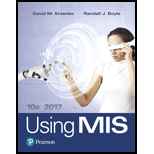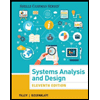
Using MIS (10th Edition)
10th Edition
ISBN: 9780134606996
Author: David M. Kroenke, Randall J. Boyle
Publisher: PEARSON
expand_more
expand_more
format_list_bulleted
Expert Solution & Answer
Chapter 8.8, Problem 8.4ARQ
Explanation of Solution
Monetize:
Monetize is defined as to convert non-revenue creating moneys into source of revenue. In economic terms, monetize is to change any objects or events into a form of currency.
Reason for generate revenue is difficult for social media:
The users expect to use social media applications with free of cost. The social media companies need to build up a big network of users rapidly, but they have to suggest a free product in order to attract users. So, the social media companies have a dilemma to how do they make money from their service, or applications.
Example revenue models for social media:
- Social media companies generate revenue in two ways that is advertising and charging for premium services.
- For example, Facebook, Instagram are creating a company pages as free of cost, but they charges a fee to advertise to communities that pages.
- Google gets revenue in making digital advertising revenue with search like searching Gmail and YouTube.
Pay-per-click:
- Pay-per-click is an internet advertising model which is used to advertiser pays money to the publisher when the advertisement is clicked.
- The publisher gets money when every time an ad is clicked.
- It is used to assess the cost efficiency and productivity of internet marketing. Every click is a way to measure interest and attention.
Conversion rate:
- Conversion rate measures the percentage of the users who visit the website and complete a transaction out of total number of users.
- Simply a conversion rate is number of users who have completed a desired goal divided by the total number of website users.
Freemium:
- Freemium is a combination of “free” and “premium”...
Expert Solution & Answer
Want to see the full answer?
Check out a sample textbook solution
Students have asked these similar questions
Specifications: Part-1Part-1: DescriptionIn this part of the lab you will build a single operation ALU. This ALU will implement a bitwise left rotation. Forthis lab assignment you are not allowed to use Digital's Arithmetic components.IF YOU ARE FOUND USING THEM, YOU WILL RECEIVE A ZERO FOR LAB2!The ALU you will be implementing consists of two 4-bit inputs (named inA and inB) and one 4-bit output (named
out). Your ALU must rotate the bits in inA by the amount given by inB (i.e. 0-15).Part-1: User InterfaceYou are provided an interface file lab2_part1.dig; start Part-1 from this file.NOTE: You are not permitted to edit the content inside the dotted lines rectangle.Part-1: ExampleIn the figure above, the input values that we have selected to test are inA = {inA_3, inA_2, inA_1, inA_0} = {0, 1, 0,0} and inB = {inB_3, inB_2, inB_1, inB_0} = {0, 0, 1, 0}. Therefore, we must rotate the bus 0100 bitwise left by00102, or 2 in base 10, to get {0, 0, 0, 1}. Please note that a rotation left is…
How can I perform Laplace Transformation when using integration based on this? Where we convert time-based domain to frequency domain
what would be the best way I can explain the bevhoirs of Laplace and Inverse Transofrmation In MATLAB.
Chapter 8 Solutions
Using MIS (10th Edition)
Ch. 8.3 - Prob. 1EGFQCh. 8.3 - Prob. 2EGFQCh. 8.3 - Prob. 3EGFQCh. 8.3 - Prob. 4EGFQCh. 8.4 - Prob. 1EGDQCh. 8.4 - Prob. 2EGDQCh. 8.4 - Prob. 3EGDQCh. 8.4 - Prob. 4EGDQCh. 8.4 - Prob. 5EGDQCh. 8.8 - Prob. 1SGDQ
Ch. 8.8 - Prob. 2SGDQCh. 8.8 - Prob. 3SGDQCh. 8.8 - Prob. 4SGDQCh. 8.8 - Prob. 8.1ARQCh. 8.8 - Prob. 8.2ARQCh. 8.8 - Prob. 8.3ARQCh. 8.8 - Prob. 8.4ARQCh. 8.8 - Prob. 8.5ARQCh. 8.8 - Prob. 8.6ARQCh. 8.8 - Prob. 8.7ARQCh. 8.8 - Prob. 8.8ARQCh. 8 - Prob. 8.1UYKCh. 8 - Prob. 8.2UYKCh. 8 - Prob. 8.3UYKCh. 8 - Prob. 8.4UYKCh. 8 - Prob. 8.5UYKCh. 8 - Prob. 8.6CE8Ch. 8 - Prob. 8.7CE8Ch. 8 - Prob. 8.1CS8Ch. 8 - Prob. 8.11CS8Ch. 8 - Prob. 8.12CS8Ch. 8 - Prob. 8.13CS8Ch. 8 - Prob. 8.14CS8Ch. 8 - Prob. 8.15CS8Ch. 8 - Using your answers to these questions, write a job...Ch. 8 - Prob. 8.17CS8Ch. 8 - Prob. 8.18MMLCh. 8 - Prob. 8.19MML
Knowledge Booster
Similar questions
- What IETF protocol is NetFlow associated with? Group of answer choices IPX/SPX IPIX HTTPS SSHarrow_forwardHow can I perform Laplace Transformation when using integration based on this?arrow_forwardWrite an example of a personal reflection of your course. - What you liked about the course. - What you didn’t like about the course. - Suggestions for improvement. Course: Information and Decision Sciences (IDS) The Reflection Paper should be 1 or 2 pages in length.arrow_forward
- using r languagearrow_forwardI need help in explaining how I can demonstrate how the Laplace & Inverse transformations behaves in MATLAB transformation (ex: LIke in graph or something else)arrow_forwardYou have made the Web solution with Node.js. please let me know what problems and benefits I would experience while making the Web solution here, as compared to any other Web solution you have developed in the past. what problems and benefits/things to keep in mind as someone just learningarrow_forward
- PHP is the server-side scripting language. MySQL is used with PHP to store all the data. EXPLAIN in details how to install and run the PHP/MySQL on your computer. List the issues and challenges I may encounter while making this set-up? why I asked: I currently have issues logging into http://localhost/phpmyadmin/ and I tried using the command prompt in administrator to reset the password but I got the error LOCALHOST PORT not found.arrow_forwardHTML defines content, CSS defines layout, and JavaScript adds logic to the website on the client side. EXPLAIN IN DETAIL USING an example.arrow_forwardusing r languangearrow_forward
arrow_back_ios
SEE MORE QUESTIONS
arrow_forward_ios
Recommended textbooks for you
 Systems Analysis and Design (Shelly Cashman Serie...Computer ScienceISBN:9781305494602Author:Scott Tilley, Harry J. RosenblattPublisher:Cengage Learning
Systems Analysis and Design (Shelly Cashman Serie...Computer ScienceISBN:9781305494602Author:Scott Tilley, Harry J. RosenblattPublisher:Cengage Learning Enhanced Discovering Computers 2017 (Shelly Cashm...Computer ScienceISBN:9781305657458Author:Misty E. Vermaat, Susan L. Sebok, Steven M. Freund, Mark Frydenberg, Jennifer T. CampbellPublisher:Cengage Learning
Enhanced Discovering Computers 2017 (Shelly Cashm...Computer ScienceISBN:9781305657458Author:Misty E. Vermaat, Susan L. Sebok, Steven M. Freund, Mark Frydenberg, Jennifer T. CampbellPublisher:Cengage Learning Principles of Information Systems (MindTap Course...Computer ScienceISBN:9781285867168Author:Ralph Stair, George ReynoldsPublisher:Cengage Learning
Principles of Information Systems (MindTap Course...Computer ScienceISBN:9781285867168Author:Ralph Stair, George ReynoldsPublisher:Cengage Learning Principles of Information Systems (MindTap Course...Computer ScienceISBN:9781305971776Author:Ralph Stair, George ReynoldsPublisher:Cengage Learning
Principles of Information Systems (MindTap Course...Computer ScienceISBN:9781305971776Author:Ralph Stair, George ReynoldsPublisher:Cengage Learning Fundamentals of Information SystemsComputer ScienceISBN:9781305082168Author:Ralph Stair, George ReynoldsPublisher:Cengage Learning
Fundamentals of Information SystemsComputer ScienceISBN:9781305082168Author:Ralph Stair, George ReynoldsPublisher:Cengage Learning

Systems Analysis and Design (Shelly Cashman Serie...
Computer Science
ISBN:9781305494602
Author:Scott Tilley, Harry J. Rosenblatt
Publisher:Cengage Learning


Enhanced Discovering Computers 2017 (Shelly Cashm...
Computer Science
ISBN:9781305657458
Author:Misty E. Vermaat, Susan L. Sebok, Steven M. Freund, Mark Frydenberg, Jennifer T. Campbell
Publisher:Cengage Learning

Principles of Information Systems (MindTap Course...
Computer Science
ISBN:9781285867168
Author:Ralph Stair, George Reynolds
Publisher:Cengage Learning

Principles of Information Systems (MindTap Course...
Computer Science
ISBN:9781305971776
Author:Ralph Stair, George Reynolds
Publisher:Cengage Learning

Fundamentals of Information Systems
Computer Science
ISBN:9781305082168
Author:Ralph Stair, George Reynolds
Publisher:Cengage Learning